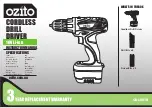
3.3.
Assembling Milling Feed Wheels.
Take the 3 handle grips with integral pivot rods and screw the threaded end of each rod into the
threaded hole in each table handle wheel. Tighten each pivot into the wheel using a 7mm spanner across the flats on each pivot rod.
3.4
Slide one wheel onto the cross feed axle ensuring that the castellations on the wheel are fully engaged with the castellations on the
axle and tighten the grub screw in the wheel collar down onto the axle with a small slotted screwdriver.
3.5
Attach the other two wheels to each end of the longitudinal feed table in the same way. (See fig1-7 & 1-13 & 1-11).
3.6
Assembling Drilling Feed Wheel.
Identify the 3 chromed handle rods with black knobs attached. One end of each rod has flats on it.
Screw this end into the drill feed hub on the right hand side of the head (See fig3-1) and tighten using a 12mm spanner.
3.7
Assembling Head Handle.
Attach a handle grip with integral pivot rod to the head handle by screwing the threaded end of the rod
into the threaded hole in the handle. Tighten the pivot rod into the handle using a 7mm spanner across the flats on the pivot rod. Note
that the stub shaft sticking out of the left side of the main body of the
machine to which the handle attaches has a flat machined across it. Push
the head handle onto the shaft. Align the hex grub screw in the with the flat
on the shaft and fully tighten using a 4mm hex key.
fig. 4
fig. 5
!
WARNING!
Before operating the drilling/milling machine ensure you are
wearing approved safety goggles to protect you from swarf and metal
particles. If using cutting oil or coolant a face mask may be necessary to
avoid breathing any vapour generated. Ensure that all other safety
instructions in chapter 1 are followed carefully.
4.1.
Head Adjustment.
To move the head up or down or to rotate it from side
to side over the bed you must first loosen the head lock nuts ( See fig.1-2 ).
Move the head up or down using the head handle ( See fig.1-16 ).
Rotate the head over the bed if required and then retighten the nuts.
4.2.
Speed Adjustment.
The table below shows the speeds obtained using
different belt combinations. Use a speed appropriate to the metal you are
cutting/drilling.
Disconnect the machine from the power supply before
changing speeds.
4.2.1
To access the drive belts raise the whole head using the head handle until
the top surface of the pulley cover is level with the top of the black cap on
top of the pillar. Unlock the pulley cover by undoing the two catches on the
right hand side of the cover and raise the cover clear of the main pillar.
4.2.2
Loosen the motor leaf screw ( See fig.2-D ) and push the motor towards
the main pillar of the machine in order to loosen the motor
belt. To loosen the other belt slacken off the two bolts holding the central pulley base plate. These are situated either side of the main pillar.
( See fig.2-E )
4.2.3
Move the belts to the desired positions and retension them by pushing the motor away from the main pillar. Tighten the motor leaf
screw first. Then retighten the two bolts holding the central pulley base plate.
4.2.4
Close and lock the pulley cover ensuring that the clearance slide is pushed back into its position within the cover.
4. SET-UP AND OPERATION
fig. 3
fig. 2
4.3
SETTING UP FOR MILLING.
( Disconnect the machine from the power supply while setting up. )
4.3.1
Engaging vertical fine feed.
Before commencing milling you should engage the vertical fine feed wheel
( See fig.3-2 ) by fully tightening the engagement knob mounted on the outside of the drill feed hub.
( See fig.3-1 ) ( This will at the same time disable the rapid drill feed. ) Set the depth stop to its maximum
so that it does not interfere with downward movement when setting the height of the milling tool.
4.3.2
Mounting the Cutting Tool.
If the drill chuck and arbor are currently mounted, remove them by
loosening the arbor bolt by two turns and giving it a tap with a rubber mallet. The arbor bolt appears at
the top of the spindle shaft and can be accessed by raising the pulley cover ( See fig.2-A ). Ensure that
the drill chuck and arbor are supported as they are removed.
4.3.3
Wear protective gloves at all times especially when handling the cutter
. Bolt the cutting tool to the
milling arbor as shown in fig.4 using the hex bolt and washer supplied. Tighten with an 8mm hex key.
Introduce the cutter assembly into the spindle sleeve and hold it in place whilst the arbor bolt is tightened
by hand. Hold the spindle pulley stationary with one hand and tighten the arbor bolt with a spanner. Do not
overtighten.
4.3.4
Attaching the workpiece
. The main bed of the machine has 4 inverted ‘T’ slots in it for fixing the
workpiece or any vice/clamping arrangement used to hold the workpiece. The dimensions of the slots are
shown in fig.5 in order to choose appropriate fixings. A 52 piece clamping kit is available as an optional
extra. Part No. SM25/52T.
4.3.5
Setting and locking the cutter height
. Once the workpiece is in place the cutter can be lowered to the
required cutting height using the vertical fine feed hand wheel. The height setting must then be locked
using the feed lock handle situated next to the depth gauge ( See fig.3-3 ).
SM25.V3 - 1 - 27/03/07
























